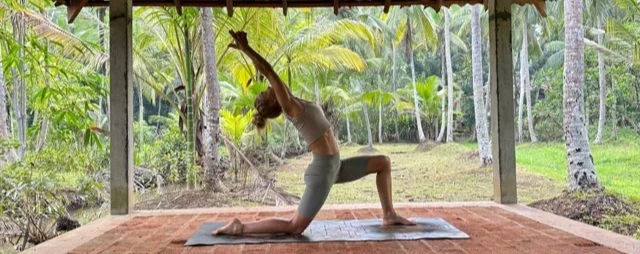It's no secret that I'm deeply fascinated by and continually in search of the flow state. I've given various talks on how to find flow at work, shared practices that explore the flow state, and in my day-to-day life, I’m constantly aware of whether I’m IN or OUT of flow. I strive to find that sweet spot where I can enter this elusive state. My daily yoga practice, especially Vinyasa, is where I engage most deeply with flow; it often feels more like a moving meditation than anything else. It’s truly my happy place.
Living in Sri Lanka has only heightened my awareness of this state. The country's Buddhist culture, with 70% of the population practicing Buddhism, has added a new dimension to my understanding. Recently, I’ve been reflecting on the connection between flow and Buddhism, as the concept of the "flow state" shares striking similarities with both Buddhist teachings and Vinyasa yoga, revealing a profound intersection.
In Vinyasa yoga, the flow state is a seamless, rhythmic movement between postures, synchronized with breath. It's a state of fluidity where practitioners become fully absorbed in the present moment, transcending the ego and tapping into effortless awareness and connection. This experience is often described as a moving meditation, where the mind quiets down and the body moves intuitively in harmony with the breath.
Similarly, Buddhist teachings emphasize cultivating mindfulness and presence in every moment. The idea of flow aligns with the Buddhist concept of "Samadhi," a state of deep concentration and absorption. In Buddhist practice, cultivating Samadhi involves training the mind to remain focused and present, free from distractions and mental chatter. This heightened awareness brings about a profound sense of clarity, tranquility, and interconnectedness with all beings.
Both Vinyasa yoga and Buddhist teachings highlight the importance of letting go of attachment, surrendering to the present moment, and fostering a sense of non-striving. In the flow state, there's a natural unfolding of movement and awareness, free from resistance or judgment. This reflects the Buddhist principle of "non-attachment" (anatta), which encourages releasing the grip on fixed identities and desires, leading to deeper liberation and inner peace.
Furthermore, both practices recognize the interconnectedness of all phenomena, embracing the fluidity and impermanence of existence. Just as Vinyasa practitioners transition seamlessly between postures, Buddhist practitioners navigate the ever-changing landscape of life with grace and equanimity, meeting each moment as it arises.
In essence, the flow state serves as a bridge between Vinyasa yoga and Buddhist teachings, embodying the principles of mindfulness, presence, and interconnectedness. Through the practice of Vinyasa yoga and the wisdom of Buddhism, individuals can cultivate a deeper understanding of themselves and the world, ultimately experiencing a profound sense of harmony, freedom, and joy.
We will delve even deeper into these connections during the Awakening Flow retreats in Sri Lanka in November 2024 and February 2025. These retreats will provide an immersive experience to explore the flow state in the context of both Vinyasa yoga and Buddhist teachings. Participants will engage in practices designed to cultivate mindfulness, presence, and fluidity, with a focus on integrating these principles into everyday life. By combining movement, meditation, and Buddhist philosophy, we’ll aim to uncover a deeper sense of flow and bring greater awareness to the profound interconnectedness of body, mind, and spirit.
- Marie-Lou, Oct 2024




